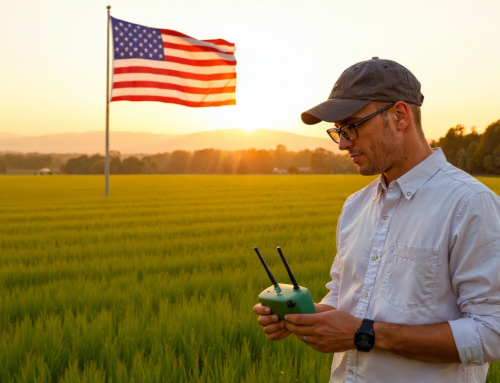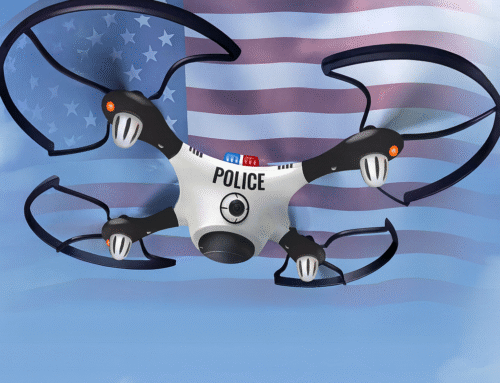The FAA aims to “unleash American drone dominance” by proposing new rules to let drones fly beyond visual line of sight (BVLOS) routinely. This long-awaited framework could end the era of case-by-case waivers for such flights.
Background: Why BVLOS Rules, and Why Now?
Drones have exploded in popularity and capability, but U.S. rules largely kept them on a short leash – literally within sight of the operator. Until now, flying beyond visual line of sight (BVLOS) required special waivers or experimental programs, a cumbersome process approved case-by-case. Over 190 BVLOS waivers had been issued by late 2024 (to 134 different operators) for tasks from university research to energy inspections. Through pilot programs like the FAA’s BEYOND, drone teams managed tens of thousands of BVLOS flights but 98% of those still needed a human visual observer as a safety crutch. The message was clear: to truly unlock drones’ potential, the FAA needed a new rule allowing routine BVLOS operations without so much red tape.
That moment has arrived. In August 2025, U.S. Transportation Secretary Sean Duffy unveiled a proposed rule called “Normalizing Unmanned Aircraft Systems Beyond Visual Line of Sight Operations”.
This Notice of Proposed Rulemaking (NPRM, Docket No. FAA–2025–1908) would establish a brand-new Part 108 in FAA regulations to govern BVLOS drone flights. The goal is to provide “a predictable and clear pathway for safe, routine, and scalable UAS operations” – including package delivery, agriculture, surveying, public safety, and more.
In short, the FAA is trying to catch regulations up to technology, so drones can do jobs currently impractical under strict line-of-sight rules.
But why now?
The drone industry’s growth and pent-up demand have reached a point where not acting means falling behind. The FAA’s own data shows over 820,000 drones are registered in the U.S. (more than half for commercial use) and 460,000+ certified remote pilots as of mid-2025. Companies like Zipline and Wing have already completed over a million BVLOS deliveries globally, often overseas or under experimental waivers in the U.S. Meanwhile, Europe and other regions implemented risk-based BVLOS frameworks years ago.
America does not want to be left behind.
The proposed rule is a bid to leapfrog from ad-hoc approvals to a comprehensive system enabling routine BVLOS flights – safely and at scale.
.@SecDuffy announced a proposed FAA rule to make Beyond Visual Line of Sight (BVLOS) drone flights safer, more secure and routine. This rule will support safer skies and expand public benefits like package delivery, agriculture and public safety. Learn how the FAA is safely… pic.twitter.com/s9swHmJato
— The FAA ✈️ (@FAANews) August 5, 2025
Key Proposals in the FAA’s BVLOS NPRM
The FAA’s BVLOS proposal is sweeping – with hundreds of pages of technical detail – but it boils down to a few core changes. It creates new compliance pathways for operators, new tech and traffic management requirements, and new operational limits intended to maintain safety.
Below, we break down the major pieces of the proposal:
Permit vs. Certification: Two Pathways for Operators
One size will not fit all BVLOS operations. There are two proposed levels of operational approval for drones flying beyond sight:
- BVLOS Permit – a quicker, simpler approval for lower-risk operations.
If your BVLOS mission involves a limited scope – small or medium drones, a limited fleet size, lower speeds, and confined operating areas – you could apply for an FAA permit rather than a full certification. The FAA envisions issuing permits relatively promptly for use cases like package delivery, farming flights, infrastructure surveying, public safety missions, training and demos, and even recreational BVLOS flying in controlled environments. A permit still requires FAA to approve the specific area and parameters of your operation, but it’s a streamlined process with less intensive oversight. Think of it as a license to conduct certain BVLOS flights without reinventing the wheel each time.
- BVLOS Operational Certificate – a rigorous certification for higher-risk, complex operations.
If you want to operate larger drones (potentially up to ~600 kg/1,320 lb), at higher speeds, with a big fleet or in more populated areas, you’ll need an operating certificate under the new Part 108. This is more analogous to an airline or commercial operator certificate. The FAA would dig into your procedures, safety mitigations, and equipment before granting it. Certified BVLOS operators must implement a full Safety Management System (SMS), detailed training programs, and will be subject to ongoing FAA oversight. In exchange, they can tackle the most ambitious drone operations. This pathway is meant for the Amazon Primes and UPS Flight Forwards of the world, or anyone pushing the envelope on unmanned aircraft capabilities.
In short: A permit is to get you flying BVLOS for defined, lower-risk missions ASAP, while a certificate is a commitment to a higher standard for broader operations. The proposal smartly offers this tiered approach, so a local agribusiness co-op and a major drone airline can each pursue BVLOS under rules scaled to their risk. (Notably, both permits and certificates would replace the need for waivers; either way, you’ll have an FAA authorization in hand.)
Airworthiness Acceptance: Drones Without Traditional Certification
Ensuring the drone itself is safe is obviously crucial for BVLOS. Today, any unmanned aircraft 55 lbs or heavier technically needs a traditional FAA airworthiness certificate (just like a manned airplane) – a process that is costly and slow, and few drones have achieved. Under the new rule, most BVLOS drones would not need a full FAA type certification. Instead, the FAA is proposing an “airworthiness acceptance” process based on industry consensus standards.
What does that mean? Industry groups and experts (through ASTM, RTCA, etc.) are developing consensus performance standards for drone hardware and software. Manufacturers could build BVLOS drones to meet those standards and thoroughly test them for safety and reliability. They would then submit a Declaration of Compliance (similar to how Remote ID drones are approved) showing the aircraft meets the accepted standards. The FAA would “accept” the drone’s airworthiness rather than certify it in-house. This streamlined approval of the aircraft could dramatically speed up getting new BVLOS designs into operation, reducing costs and paperwork.
Some guardrails still apply. Under this proposal, eligible unmanned aircraft must be under 1,320 pounds (600 kg) gross weight including payload – a limit that covers large drones and small urban air mobility vehicles, but not anything human-carrying. (It’s essentially aligning with the definition of “small” sport aircraft.) Drones used for Part 108 BVLOS ops must also be equipped with certain tech for safety: for example, they’ll be required to have onboard lighting and to broadcast Remote ID signals for visibility and accountability.
Detect-and-avoid (DAA) capabilities will be mandatory on BVLOS drones as well. This means drones must be able to automatically sense other aircraft or obstacles and take evasive action if a collision risk arises – without needing a pilot’s eyes on the scene. In practice, DAA could involve radar, optical sensors, acoustic detectors, or network-based solutions that alert the drone to get out of the way. The bottom line is drones will have to be smart and self-aware in the sky. By combining robust design standards with modern tech like DAA, the FAA hopes to maintain aviation safety even without the human eyeballs that used to be required on every drone flight.
Strategic Deconfliction & UAS Traffic Management (UTM): Keeping Drones Apart
Flying beyond sight means you can’t just look out for other aircraft – so the proposal introduces a new system of “strategic deconfliction” using network services. The key players here are called Automated Data Service Providers (ADSPs). These are essentially FAA-approved UTM services that will help drones avoid crashing into each other (and into manned airplanes).
Under the rule, most BVLOS operations would be required to utilize an ADSP for flight planning and separation. An ADSP could be a third-party company (or the operator themselves, if they set up the service) that coordinates drone flights in a given area. Before takeoff, your drone would submit its planned route and timing to the ADSP, which would check it against other known drone trajectories and known air traffic info. The ADSP can then deconflict flights strategically – e.g. adjust schedules or routes so two drones don’t hit the same point at the same time. The ADSP will also tap into data about manned aircraft; importantly, all drones must yield right-of-way to any manned aircraft broadcasting its position (ADS-B Out or similar). The network can warn drones of approaching manned planes and ensure they stay clear.
To make this work, the FAA will establish a new Part 146 for ADSPs – creating a framework to approve and regulate these UTM service providers. ADSPs will have to conform to performance standards, pass FAA vetting and testing, and operate with high reliability and cybersecurity. Think of it as air traffic control, but automated and tuned for drones. It’s a bold idea, essentially outsourcing separation to cloud-based services and onboard tech rather than human controllers watching every drone. The FAA has already been testing UTM concepts through trials, and this rule would formalize it: no ADSP service, no routine BVLOS at scale.
Not every tiny drone flight will need an ADSP, though. If you’re in truly isolated airspace with only one drone, the FAA might not require a network solution. But as population density or air traffic increases, the rule would mandate more sophisticated deconfliction measures. For example, any BVLOS operation over a certain population threshold (more on those categories next) would have to use approved strategic conflict detection and resolution tools. This ensures that in busier skies, drones aren’t just winging it (pardon the pun). The proposal essentially layers requirements: in low-risk airspace, simpler methods suffice; in higher-risk areas (like suburbs or cities), you must use an ADSP and possibly other services like conformance monitoring to track that the drone stays on its approved course.
Another twist: the FAA is proposing a change to right-of-way rules. Historically, manned aircraft always had priority over unmanned. Under Part 108, if a manned aircraft is “non-cooperative” (i.e. not broadcasting ADS-B or any electronic signal) and it’s outside major airports or controlled airspace, the drone might actually have right of way. This means a crop duster or vintage plane flying low with no transponder would legally need to stay clear of any Part 108 drones. It’s a controversial shift – essentially encouraging manned aircraft to use “electronic conspicuity” devices to announce themselves if they want to ensure drones yield. The FAA stopped short of requiring ADS-B Out on all low-flying manned planes (citing cost concerns), but they plan to develop a cheap portable beacon such pilots could carry. In busy airspace (Class B/C, near airports, or densely populated areas), manned aircraft still retain right-of-way even if not broadcasting – drones must detect and give way to any intruders in those sensitive zones. But in the open skies of rural America, the FAA is signaling that drones belong too, and everyone needs to share responsibly. It’s a bold approach that will no doubt get heavy feedback from general aviation communities.
Operations Over People (and in Different Airspaces): The Population Density Categories
Flying over people has always been a hot-button issue for drones. The proposed BVLOS rule would allow operations over people by default – but with strict conditions based on how many people are underneath. Specifically, the FAA is introducing five population density categories for BVLOS operations over people, ranging from sparsely populated to highly urban. The higher the population density, the more mitigations and limitations apply. This risk-based model acknowledges that a drone failing over an empty field isn’t the same as one failing over a city block.
While the NPRM doesn’t explicitly label them “Category 1, 2, 3, 4, 5” in the summary, conceptually you can imagine:
- Category 1 – essentially unpopulated or very sparse (farmland, wilderness). Minimal extra restrictions.
- Category 2 – low density (rural towns or spread-out suburbs).
- Category 3 – moderate density (suburban or light urban environments).
- Category 4 – high density (urban downtowns).
- Category 5 – very high density (major city centers).
Each step up adds layers of required safety. For instance, higher categories might require more robust DAA systems, mandatory use of an ADSP for strategic deconfliction, and perhaps altitude or speed constraints. The FAA plans to use real data (such as Oak Ridge National Lab’s LandScan population data) to objectively classify areas by people-per-square-km. Importantly, all BVLOS operators would have to know what category of airspace (by population) they’re flying over and stay within their approved category limit. A permitted operator will likely be limited to lower population categories (e.g. only rural ops), whereas certificated operators with more advanced safety cases could tackle higher-density areas. The FAA explicitly anticipates limiting permit holders to categories 3 and below in most cases – meaning routine urban BVLOS might initially be only for those who go through the full certification process.
No matter the category, one absolute prohibition is flying over “open-air assemblies” of people. The rule flat-out bans BVLOS flights over large gatherings like concerts, sports events, parades, or any crowded open area unless you obtain a special authorization. The FAA doesn’t strictly define how many people make an “open-air assembly” – it could even be a busy beach or park depending on circumstances. The message: don’t fly a drone over big crowds. If for some reason there’s a compelling need (say, a public safety drone monitoring a festival), the FAA would handle that via separate case-by-case approval.
As for airspace classes: Part 108 doesn’t outright prohibit BVLOS flights in controlled airspace (like near airports or in Class B/C). However, operations in controlled airspace will require coordination and likely extra tech. For example, if you’re near a major airport or in Class B/C, your drone must be able to detect and yield to all manned traffic – even the “non-cooperative” ones. In practice, that means no drone is going to just wander into busy airspace without a very tight integration with Air Traffic Control or an ADS-B surveillance net. The FAA is working on procedures to handle BVLOS in controlled airspace; it might involve requiring special permission (just as Part 107 pilots now request via LAANC for controlled airspace, perhaps Part 108 will have an equivalent). The proposal’s emphasis on not interfering with airports, heliports, or eVTOL vertiports is strong. Drones cannot disrupt existing traffic patterns of crewed aircraft – so expect strict rules around approach paths and airport vicinity. All told, BVLOS flights will predominantly be at 400 feet AGL or below nationwide (the long-standing altitude limit for small drones holds here), which helps segregate them from most manned flights anyway.
New Roles: Operations Supervisor and Flight Coordinator
The proposed rule doesn’t just regulate tech and airspace – it also addresses the people behind the drones. Interestingly, the FAA is not requiring every BVLOS pilot to hold a Part 107 remote pilot certificate. Instead, for certificated operations, the rule introduces two key roles that an operator organization must fill:
- Operations Supervisor: This person has ultimate responsibility for safety and regulatory compliance in the BVLOS operation. They’re like the project manager of the drone mission. The operations supervisor must ensure all flights adhere to the rules and the specific operating limitations of the drone, and confirm that all crew members are trained and competent. They would oversee risk assessments, check that conditions are safe, and have the authority to abort missions if needed. Essentially, it’s the adult in the room who owns the safe conduct of the operation.
- Flight Coordinator: This role is more tactical – the flight coordinator actively monitors the drones in flight and can intervene if safety is at risk. Think of this person as an air traffic coordinator for your company’s drones. They would watch the real-time telemetry, ensure the drones stick to plan, and manage any contingency (like if a communication link drops or weather changes suddenly). One flight coordinator might oversee multiple simultaneous drones, depending on the operation, but they need to be ready to step in and adjust or terminate a flight to maintain safety.
Crucially, neither the operations supervisor nor the flight coordinator is required to hold an FAA pilot certificate. The FAA is not mandating that these individuals be licensed manned pilots or even Part 107 remote pilots. This is a bit surprising – it implies the FAA is allowing companies flexibility in staffing, as long as the individuals are properly trained under the company’s program. They will, however, be vetted for security: the Transportation Security Administration (TSA) will require background checks for these positions. Specifically, TSA would impose up to a Level 3 Security Threat Assessment including watchlist vetting, immigration status check, and a fingerprint-based criminal history check for operations supervisors, flight coordinators, and other sensitive personnel. This is akin to what manned aircraft pilots and airport workers go through. Additionally, any BVLOS operation involving package delivery (permit or certificate) would need a TSA-approved security program in place– meaning protocols to prevent tampering or misuse of drones for nefarious purposes.
The presence of TSA in this rule is notable. It shows the government is thinking ahead about drone security threats (e.g. someone using a drone to carry a weapon or cause harm). Operators will have to implement physical security measures (like securing drone staging areas) and cybersecurity measures to protect command links and data. They’ll need contingency plans for cyber-attacks and a way to measure and improve their security over time. Manufacturers, too, must design drones to resist hacking or jamming. While this adds burden, it’s hard to argue against in today’s security climate – drones will only win public trust if they’re not easily knocked out of the sky or hijacked.
For smaller-scale permit operations, the FAA hasn’t explicitly said if an operations supervisor and flight coordinator are required in every case. It may be that these roles are only mandated for the higher-risk certificated ops. But even a permit holder will likely need a clear chain of responsibility and someone managing flights. At the end of the day, humans are still accountable for drone safety, even in an automated BVLOS world.
Data Requirements: Reporting and Recordkeeping
With greater freedom comes greater accountability. The BVLOS NPRM layers on a host of reporting and recordkeeping requirements for operators – reflecting a “trust, but verify” philosophy to ensure safety data is collected.
Operators would have to report certain incidents and data to the FAA on a regular basis. For example, they’d likely need to report any unplanned or precautionary landings (did your drone have to land somewhere other than the intended spot?), any loss of control or link issues that result in leaving the approved area, any malfunctions that could pose a risk, and certainly any operation that results in injury or property damage over $500. Reports would also cover security breaches – if someone hacks your drone or your system, or if an unauthorized person accessed your control station, you must tell the FAA. Even an ADSP service failure that affects your operation would likely be reportable. This data will help regulators track how the BVLOS integration is going and catch systemic issues.
On the recordkeeping side, operators must keep detailed logs of their activities. Expect requirements to log every flight’s details (date, time, route, purpose, drone ID, crew involved), as well as maintenance and inspection records for each drone. Training records for personnel need to be maintained, plus records of any alterations or software updates to the drones. Basically, if it’s something that impacts safety, write it down and file it. These records must be available for FAA inspection upon request. Manufacturers of accepted drones would also have to keep records proving continued airworthiness – like test data, any field issues that arise, and configuration control documents to know what hardware/software is in each drone. Even ADSPs have recordkeeping duties (e.g. logging software version changes and uptime/accuracy stats).
All this might sound bureaucratic, but it’s similar to what manned aviation does. When you normalize BVLOS to be a routine part of the airspace, you also normalize the oversight. The FAA wants to gather data to refine rules over time – for instance, if certain types of incidents become frequent, they can address them via policy or updated standards. It’s also a way to assure the public that BVLOS drones are being monitored in aggregate. The days of the FAA knowing little about what drones are up to (as in the early hobbyist era) are ending, at least for commercial BVLOS ops.
Potential Benefits of the New BVLOS Drone Rules
If adopted, these changes could unlock tremendous economic and societal benefits that were previously bottled up by restrictive regulations. Here are some key positives:
- Scaling Up Industry Operations: No more case-by-case waivers means companies can plan investments and services with regulatory certainty. Routine BVLOS authority lets businesses roll out drone delivery networks, expansive agricultural monitoring, long-range infrastructure inspections, and more. Sectors like logistics, farming, energy, and construction stand to gain efficiency. AUVSI (the Association for Uncrewed Vehicle Systems International) calls the draft rule “a critical step toward enabling drone operations that will enhance safety, transform commercial services, and strengthen public safety…unlocking new applications…driving billions in economic growth, and creating high-quality jobs.” Bold words, but not unrealistic – one analysis projects the global drone market to grow to ~$58 billion by 2030 on the back of expanded operations. Enabling BVLOS in the U.S. could solidify American companies’ share of that pie (and keep drone tech development and jobs from migrating overseas).
- Public Services and Safety: BVLOS isn’t just about commerce. Think of search-and-rescue drones covering large areas beyond a pilot’s sight, or wildfire monitoring drones that can fly miles out to track a fire line, or medical delivery drones zipping defibrillators or medicines across town. All these use cases become far more viable with a clear BVLOS rule. In fact, during the pandemic and beyond, companies like Zipline, Wing, and Matternet have trialed medical deliveries and shown life-saving potential. Normalizing BVLOS could make such services routine – the drone delivering your prescription might be as unremarkable as the mail truck. And for first responders, drones that can be deployed remotely to an incident (to give situational awareness before crews arrive, or even to actively assist) are a game-changer. The rule’s emphasis on security and reliability means public safety agencies can trust these drones to do their jobs without causing new problems.
- Maintaining Aviation Safety: It’s a bit counterintuitive, but formalizing BVLOS operations could enhance overall airspace safety by bringing all players under standardized requirements. Today, some drone flights beyond line of sight happen under exemption or ignorance, potentially without consistent safety practices. The new rules mandate detect-and-avoid tech, network deconfliction, and communications protocols that will reduce the chance of mid-air collisions or lost drones. For example, requiring drones to yield to broadcasting aircraft ensures manned planes (especially those with ADS-B Out or portable beacons) should rarely encounter an oblivious drone. Moreover, by collecting incident reports and data, the FAA and industry can proactively fix issues. It’s similar to how commercial aviation improved through shared safety reporting. In the long run, integrating drones with systems like ADS-B, traffic info, and network services might increase situational awareness for all airspace users – a benefit as Advanced Air Mobility (think air taxis and larger uncrewed aircraft) come online too.
- Reducing Costs and Delays: The airworthiness acceptance process based on consensus standards could vastly reduce the cost of bringing a drone to market versus full FAA certification. That means more competition, more innovation, and lower costs for operators. Likewise, using automation and third-party services (ADSPs) may prove more scalable than hiring legions of air traffic controllers for low-altitude airspace. Small businesses and startups could enter the BVLOS arena via the permit pathway without needing an army of regulatory lawyers. All told, the rule can democratize access to beyond-line-of-sight flight – which until now has been mostly the domain of well-funded corporations doing trials. We could see, for instance, a local drone cooperative get a permit to monitor crops across a county, boosting yields for family farms with affordable drone data.
- Global Leadership and Standards: The U.S. has lagged a bit behind regions like Europe in codifying drone risk-based rules. By implementing Part 108, the FAA signals that the U.S. intends to lead in operationalizing advanced drone concepts. This can influence global standards (via ICAO or JARUS) and ensure American companies aren’t hamstrung at home while competitors roam free abroad. As Secretary Duffy put it bluntly, “Thanks to President Trump, America – not China – will lead the way in this exciting new technology.” Politics aside, having a clear U.S. framework can boost investor confidence and keep R&D momentum stateside.
Risks, Challenges, and Unanswered Questions
No regulation is perfect, especially not on first draft. The BVLOS NPRM, while groundbreaking, raises critical questions and some concerns that will need to be addressed:
- Right-of-Way Controversy
Perhaps the most polarizing change is giving drones right-of-way over some manned aircraft in certain situations. This flips a century of aviation convention on its head. Pilots’ associations like AOPA are understandably cautious – they worry about non-ADS-B equipped aircraft (which include many small planes and helicopters) suddenly having to dodge drones they can’t see. There’s also concern that encouraging pilots to carry new “electronic conspicuity” gadgets to retain right-of-way might not achieve full compliance (some pilots resist mandates or may not afford new devices). If a mid-air collision occurred because a manned aircraft without ADS-B flew into a drone’s path, public perception could turn sharply against drones – regardless of what the rulebook says about right-of-way. The FAA will have to carefully analyze comment feedback on this proposal. Perhaps they’ll refine it to ensure practical deconfliction – e.g. require drones to always yield below a certain altitude unless positive deconfliction via ADS-B/ADSP is in place. The technology to detect non-cooperative aircraft (like optical or acoustic sensors and ground radar) is improving, but not foolproof. What if a low-flying medical helicopter or crop duster doesn’t broadcast its position? The rule leans on drones having DAA systems to detect it anyway, but that’s a tall order. This area is likely to be a hot debate in the comments.
- Operational Complexity and Cost
While the rule removes waivers, it adds operational burdens. Using an ADSP service, equipping DAA sensors, performing extensive recordkeeping – these all cost money and effort. Small operators or hobbyist clubs might find the requirements daunting, even under a “permit.” For example, will a rural RC plane club that wants to do occasional beyond-line-of-sight flights need to subscribe to a network service and hire a flight coordinator? The FAA does include recreational BVLOS in the list of possible permit ops, which is intriguing, but U.S. law (49 U.S.C. 44809) currently requires hobbyists to fly within visual line of sight. It’s unclear if or how the final rule will reconcile that. Perhaps the upcoming FAA Reauthorization Act will tweak the hobby rules. In any case, some drone enthusiasts fear that only well-funded entities will fully benefit from Part 108, while independent operators might struggle with compliance cost. If ADSP services are too expensive or not available in certain areas, does that ground BVLOS ops there? The FAA will need to foster a competitive, accessible ecosystem for UTM services so that even a small-town fire department can afford to use one when needed.
- Technology Maturity
The vision of Part 108 leans heavily on technologies that are still maturing: reliable detect-and-avoid, robust command & control links, and interoperable UTM systems. What if these systems don’t perform as expected? For instance, if two different ADSPs are operating in neighboring areas, how do they share data to prevent conflicts at the boundary? There is work underway (NASA and industry partners have trialed UTM interoperability), but it’s not yet like the seamless air traffic control system. DAA sensors, on their part, have limitations: cameras don’t work well in fog or glare, radar on small drones has limited range, and acoustic sensors might not detect quiet gliders. The FAA’s performance-based approach (not prescribing exact tech, just required capability) is wise, but the devil is in the details. The rule will likely rely on industry standards (ASTM, etc.) for DAA performance. If those standards aren’t ready or if companies can’t meet them cheaply, implementation of the rule could be slow. We might see a gap where the rule is finalized but few operators qualify immediately because they need to upgrade tech or wait for ADSP networks to expand.
- Airspace Integration and ATC Workload
The proposal tries to keep drones at low altitudes and away from airport traffic. But as BVLOS ops grow, inevitably some will want corridors that rub against controlled airspace. How will air traffic control (ATC) handle potentially thousands of drones? The idea is that ATC won’t actively separate Part 108 drones except when they impinge on controlled airspace – the ADSP and strategic deconfliction keep drones contained. Still, there could be corner cases: e.g., an emergency drone operation that needs to briefly enter Class D airspace of a small airport – how quickly can that be approved and communicated? The FAA will need new procedures and possibly automation to handle drone clearance requests (an extension of today’s LAANC system). Controllers might also get alerts from ADS-B about nearby drones if pilots are broadcasting – but recall, drones under Part 108 cannot use ADS-B Out or transponders in transmit mode (to avoid overloading the surveillance network). That means controllers won’t see most drones on their radar scopes. They have to trust that the drone ops are staying in their lane. This “out of sight, out of mind” approach could be disconcerting for pilots and controllers at first. Building trust in the UTM system will take time. The FAA plans to use remote ID and network reporting to have situational awareness of BVLOS drones, but this likely means new displays or data feeds for ATC in the future – none of which are fully deployed yet.
- Enforcement and Compliance
Writing rules is one thing, enforcing them is another. How will the FAA ensure that only compliant operators fly BVLOS? They’ll have the data reporting to spot issues, but initially there may be gray areas. For instance, someone might attempt BVLOS flights just under Part 107 rules claiming a visual observer is somewhere down range, when in fact it’s quasi-BVLOS. Will the introduction of Part 108 mean FAA ramp checks or audits to catch people avoiding the new regs? Possibly – and enforcement might need to ramp up to keep the playing field fair. There’s also the risk of rule confusion: Part 107 remains for VLOS operations; Part 108 for BVLOS. If someone with a Part 107 certificate wants to do a one-off BVLOS flight in rural land, do they go get a Part 108 permit? Or do they still get a one-time waiver under Part 107? The FAA might discontinue most waivers once Part 108 is live, forcing everyone into the new system. Transitioning the industry smoothly will be a challenge.
- Timeline and Iteration
Finally, we should note this is a proposed rule. It’s not in effect yet. The FAA has opened a 60-day public comment period (through early October 2025). Given the complexity, they’ll likely get thousands of comments from stakeholders – hobbyists, airlines, tech companies, manned aviators, law enforcement, you name it. It may take a year or more to produce a final rule after digesting comments (especially if major changes are needed). Optimistically, we might see a final Part 108 rule in late 2026, with implementation phased in 60 or 180 days after that. This means the routine BVLOS era is not starting tomorrow – there’s still a lot of process to go. Moreover, some pieces could be carved out or adjusted. For example, if the industry argues that five population categories are overkill, the FAA might simplify it. Or if security agencies raise concerns, there could be added restrictions.
The NPRM is bold and broad; history tells us final rules tend to be a bit more conservative. Keep an eye out for how the FAA addresses the toughest questions – because that will determine just how open the skies get.
FAQs on the FAA’s 2025 Proposed BVLOS Drone Rules
What are the new BVLOS drone rules about?
They are a proposed set of regulations to allow drones to routinely fly beyond the operator’s visual line of sight (BVLOS) without needing a case-by-case waiver. The FAA wants to create a clear, scalable framework for safe BVLOS operations for industries like delivery, agriculture, public safety, and infrastructure inspection.
Why is the FAA introducing these rules now?
The FAA is acting because drone technology and demand have advanced beyond the limits of current rules. Over 820,000 drones are registered in the U.S., and other countries already have BVLOS frameworks. Without updated regulations, the U.S. risks falling behind in innovation and global competitiveness.
What is the difference between a BVLOS Permit and a BVLOS Operational Certificate?
A permit is for lower-risk, smaller-scale BVLOS operations and is quicker to obtain. A certificate is for larger, faster, or more complex operations in populated areas and requires a higher safety standard, detailed procedures, and ongoing FAA oversight.
Will drones need traditional FAA airworthiness certification?
Not for most BVLOS drones. Instead, they can meet industry consensus safety standards and submit a Declaration of Compliance for FAA acceptance. This speeds up approvals and lowers costs compared to full certification.
What safety technology will BVLOS drones need?
They’ll need Remote ID, onboard lighting, and Detect-and-Avoid (DAA) systems to sense and avoid other aircraft or obstacles automatically.
What is an ADSP, and why is it important?
An Automated Data Service Provider (ADSP) is like a traffic coordinator for drones. It manages flight planning, separation, and conflict avoidance using a network service. Most BVLOS flights will need to use an FAA-approved ADSP.
How will right-of-way rules change?
In some rural areas, drones may have right-of-way over manned aircraft that aren’t broadcasting their position. In controlled or busy airspace, manned aircraft will still have priority.
Can drones fly over people under these rules?
Yes, but with limits. Operations will be classified into five population density categories, with stricter safety requirements in more crowded areas. Flying over large open-air gatherings is banned without special approval.
Are there new roles for people managing BVLOS flights?
Yes. Larger-scale operations will require an Operations Supervisor (overall safety and compliance) and a Flight Coordinator (real-time monitoring and response). These roles don’t require a pilot licence but do require TSA security checks.
What kind of reporting and recordkeeping will operators need to do?
Operators must log every flight, maintenance, and personnel training. They also have to report incidents like malfunctions, security breaches, and significant property damage.
What are the main concerns or challenges with the proposal?
Key concerns include potential conflicts with manned aircraft, high compliance costs for small operators, reliance on maturing technology, and ensuring smooth integration with existing air traffic systems.
Are the rules final?
No. They are a proposal open for public comment until early October 2025. The final rules may not take effect until late 2026 or later, depending on revisions.
Will recreational drone pilots be affected?
Possibly. Recreational BVLOS is mentioned in the permit pathway, but current U.S. law still requires visual line of sight for hobbyists. Changes for recreational users may depend on updates to federal law.
What should operators do now to prepare?
Stay informed, submit comments to the FAA, assess your technology for compliance (especially DAA and Remote ID), and plan whether a permit or certificate fits your intended operations.






